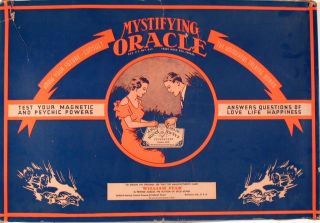Alexander Grelier
12/12/18
12/12/18
Material Culture: Ouija Boards
 |
| Psychology Today: The Ouija Board Explained |
 |
| University of Texas: Spiritualism |
 |
| APPI Ghost Hunts & Tours: Origins of Ouija |
One of the two main factors that allowed the Ouija Board to be marketed successfully is the Modern Spiritualism craze in the 19th century. Spiritualism has been around for centuries, but a huge modern spiritualism wave began after Civil War, when people had lost loved ones to the war, and desperately yearned to contact them. According to an article written by the Victorian Web, the idea of modern spiritualism truly began in the 1860's after two sisters claimed that they had spoken with a man that had died in their house years before. Families that heard this news would hire mediums to come and conduct seances to have a hope of contacting their dead friend and family. The idea of "talking boards" to contact the dead had been around for a long time as well, but it wasn't until 1886 in Ohio where the idea resurfaced and became mainstream when a camp full of spiritualists claimed to have used these boards to talk to the dead. Charles Kennard, Elijah Bond, and Washington Bowie saw this as a major opportunity that needed to be capitalized on so they came together and raced to be the ones that got their own talking boards patented. They would issue their patent in 1890 and receive it in 1891, after proving it to work in front of the United States Patent and Trademark Office. They would then begin to mass produce this product, and play into feelings of consumers to make the Ouija Board a huge hit among families all across the nation.
One main factor that allowed the Ouija Board to be successful is the rise of material culture in America in the 19th century. Elijah Bond and his partners when advertising their new product used catchphrases such as "The Mystifying Oracle", "Test Your Psychic Powers", and "Answers Questions of Love, Life, Happiness", intriguing and mystifying consumers across the nation. These advertisements reached consumers using catalogs, billboards, and department stores with large display windows that had become mainstream at just around the same time as the surfacing of the Ouija Board, in the late 19th century. On top of advertisements being able to reach almost everyone in the nation, these boards were also very much affordable and mass produced with new innovations such as the assembly line to make them, along with the planchettes. Ouija boards hit department and retail stores in the 1890's at a cheap price, being marketed for under a dollar. The combination between the price of the board, and the mystery and interest surrounding spiritualism at the time allowed the Ouija board to be a big hit in department stores all around the nation.
Looking back on my essay with my notes: I should have added that the marketing of the Ouija Board wasn't all smooth and easy, as there were many objections and warnings from the Catholic Church to turn Christians away from the Ouija Board. The church regarded the board as "a monster in sheep's clothing" and "evil".
Looking back on my essay with my notes: I should have added that the marketing of the Ouija Board wasn't all smooth and easy, as there were many objections and warnings from the Catholic Church to turn Christians away from the Ouija Board. The church regarded the board as "a monster in sheep's clothing" and "evil".
Sources
Victorian Web: Victorian Spiritualism This source is where I found information on the origins of modern spiritualism
Waterbury Evening Democrat This is an article from a newspaper written in 1891, and I found information about warnings from the Catholic Church regarding the Ouija Board from it
Smithsonian Mag: The Strange and Mysterious History of the Ouija Board This article is where I found most of my information! Some examples include facts about the history of talking boards, Elijah Bond, the spiritualist camp in Ohio, the rise of spiritualism in 19th century America, and the patenting of the first ever Ouija Board
(I got my information about material culture, marketing, and innovation in the late 19th and early 20th century from our textbook.)
Comments
Post a Comment